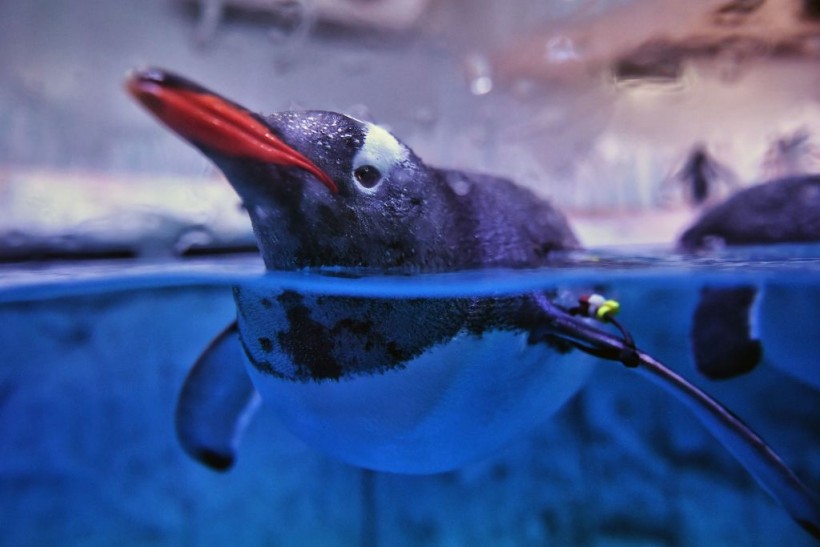Melanism is a rare genetic condition that causes an excess of dark pigment called melanin in the skin, fur, or feathers of an animal.
It is the opposite of albinism, which is a lack of pigment. This condition can occur in many different animal species, but it is extremely rare in penguins.
Recently, a team of biologists from Argentina reported a case of melanism in a wild gentoo penguin living in Antarctica.
This is the second time that such a phenomenon has been observed in this species, and it raises some interesting questions about the evolution and ecology of these charismatic birds.
What is a gentoo penguin?
 (Photo : LILLIAN SUWANRUMPHA/AFP via Getty Images)
(Photo : LILLIAN SUWANRUMPHA/AFP via Getty Images)

Gentoo penguins are the third largest penguin species, after the emperor and king penguins. They can reach up to 30 inches in height and 12 pounds in weight.
They have black backs and white bellies, with distinctive white patches above their eyes and orange-red bills and feet.
They live on the Antarctic Peninsula and several subantarctic islands, where they form large colonies of breeding pairs.
These animals feed mainly on fish, squid, and krill, which they catch by diving as deep as 655 feet and swimming as fast as 22 miles per hour.
Gentoo penguins are adapted to cold environments, but they prefer ice-free areas with grass or rock for nesting.
They are monogamous and highly nurturing parents, who take turns incubating two eggs and caring for the chicks until they are ready to fledge.
Gentoo penguins are generally considered to be near threatened by the International Union for Conservation of Nature (IUCN), due to habitat loss, climate change, pollution, and overfishing.
How did melanism occur in a gentoo penguin?
The melanistic gentoo penguin was spotted by the Argentine biologists at Esperanza/Hope Bay, on the tip of the Antarctic Peninsula.
It was standing next to normal-colored conspecifics, showing no signs of ill health or abnormal behavior.
The researchers took photographs and measurements of the bird, and compared it with other gentoo penguins from different populations.
They found that the melanistic penguin had a larger body size and bill length than average, but was within the normal range of variation for the species.
The researchers speculated that the melanism was caused by a mutation in one or more genes that regulate the production and distribution of melanin in the feathers.
Melanin is responsible for giving color to the skin, hair, eyes, and feathers of animals. It also protects them from ultraviolet radiation and helps them regulate their body temperature.
In most penguins, melanin is concentrated on the back and head, creating a black-and-white pattern that helps them camouflage from predators above and below the water surface3.
However, in some rare cases, melanin can be overproduced or misplaced, resulting in darker or lighter coloration than normal.
This can be influenced by genetic factors, environmental factors, or both.
For example, some animals may develop melanism as a response to colder or darker habitats, where darker coloration may provide more warmth or camouflage.
However, this is unlikely to be the case for the gentoo penguin, since it lives in a relatively mild and bright environment compared to other Antarctic penguins.
The researchers suggested that the melanism was probably a random mutation that occurred during the development of the bird or its parents.
Such mutations are not uncommon in nature, but they are usually eliminated by natural selection if they reduce the fitness or survival of the individual.
Nevertheless, if the mutation does not have any negative effects on the individual's health or reproduction, it may persist in the population or even spread if it confers some advantage.
Also Read: Where on Earth Did the King Penguins Go?
What are the implications of melanism for gentoo penguins?
The researchers noted that there are very few records of melanism in penguins and only one previous report of a melanistic gentoo penguin from 2010.
That bird was found on South Georgia Island and had almost completely black plumage on its front and back.
The researchers compared the two cases and found that they were different types of melanism: the South Georgia bird had uniform melanism, while the Esperanza bird had partial melanism.
The researchers also pointed out that there is evidence that gentoo penguins are not one single species, but four distinct ones: Pygoscelis taeniata from Kerguelen Island; Pygoscelis papua from Falkland Islands; Pygoscelis ellsworthi from Antarctic Peninsula and South Shetland Islands; and Pygoscelis poncetii from South Georgia.
These four species differ in their morphology, genetics, behavior, and ecology.
The researchers suggested that the occurrence of melanism in two different species of gentoo penguins may indicate that this trait has a common origin or a convergent evolution in these birds.
The study concluded that the melanistic gentoo penguin from Esperanza represents a rare and interesting case of natural variation in penguins and that more studies are needed to understand the causes and consequences of melanism in these birds.
They also emphasized the importance of conserving the diversity and uniqueness of Antarctic wildlife, which is facing multiple threats from human activities and climate change.
Related article: The Story Behind Two Widowed Penguins of Melbourne Skyline
© 2024 NatureWorldNews.com All rights reserved. Do not reproduce without permission.





